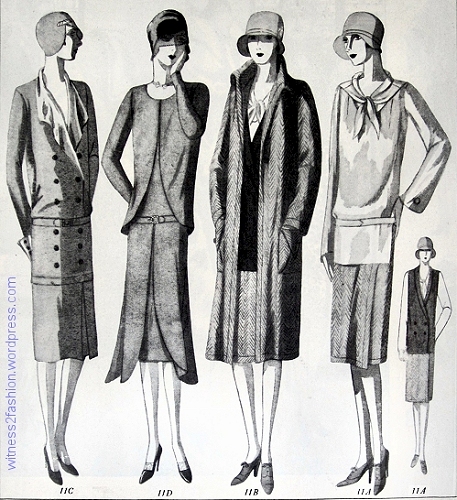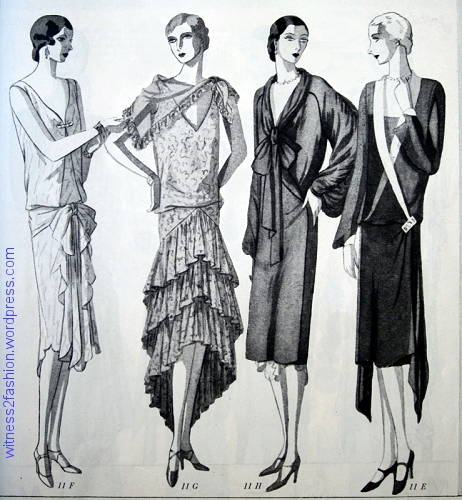Butterick issued eight more “Forecast” patterns, at $1.00 each, in March of 1928. Although the illustrations were large, the accompanying text was quite brief.
The two-page spread was titled “The Forecast Wardrobe Lays Complete Plans for Spring.” Butterick pattern numbers 11 A through 11 H cost $1.00 each, twice as much as normal, four-digit Butterick patterns cost in 1928. L. Frerrier did the illustrations again, but there was no lavish background scenery. In fact, I find this set of patterns rather unexciting.

Daytime fashions: Butterick Forecast Wardrobe patterns 11C, 11D, 11B and 11A from Delineator, March 1928, p. 30.

Evening fashions: Butterick Forecast Wardrobe patterns 11 F, 11 G, 11 H, and 11 E, from Delineator, March 1928, pg. 31. Illustrations by L. Frerrier.
A “Wardrobe” pattern from the 1960’s or 1970’s usually included tops, skirts, trousers or shorts, and a jacket or coat, so that the buyer could plan a large, color-coordinated wardrobe. The daytime coat 11 B was intended to be worn with the blouse/skirt/vest pattern 11 A, but not necessarily with any other patterns in this series.

Butterick Forecast Pattern 11 A. March 1928. The wrap skirt does not have a waistband; instead it hangs from the shoulders on a slip- or chemise- like “underbody.” The “scarf” is part of the back yoke and collar.

Butterick Forecast Wardrobe pattern 11 B, March 1928. Perhaps because it’s intended for spring, the coat cannot be fastened.

Butterick Forecast Wardrobe pattern 11 C, March 1928. This “formal sport frock” is really a tunic and a separate skirt.

Butterick Forecast Wardrobe pattern 11 D, March 1928. In the twenties, a “bolero” was often hip length, and, like this one, part of the dress, not a separate jacket. This would definitely look better with a fox fur “scarf,” since the neckline is very plain.

Butterick Forecast Wardrobe pattern 11 E, March 1928. The diagonal “surplice” closing was often recommended as “slimming” to the woman who wore larger sizes. This pattern was available up to size 44 inch bust, with a 47.5 inch hip.

Butterick Forecast Wardrobe pattern 11 F is a moire taffeta evening dress, March 1928. By 1928, snug hip bands like this, with a blouson effect above them, were quite chic.

Butterick Forecast Wardrobe pattern 11 G, a lace evening gown, from March 1928. High-in-front-low-in-back hems hint that a change in length is coming. This dress would look very different with pleats (“plaits”) rather than ruffles. Note the tight hip.

Butterick Forecast Wardrobe pattern 11 H, an evening coat with raglan sleeves. March 1928. You can see a line of gathers (shirring) on the sleeves. 7/8 length coats were another sign that hem length was in transition in 1928.










